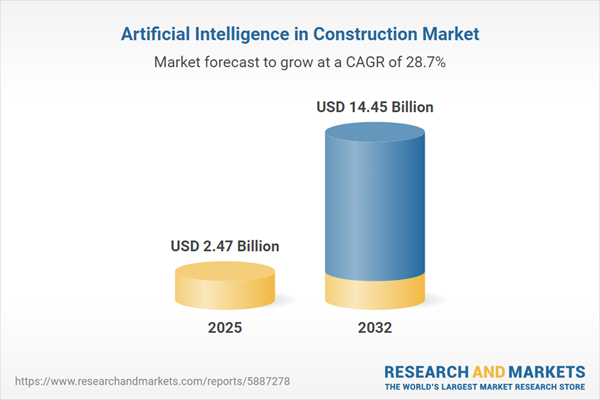Speak directly to the analyst to clarify any post sales queries you may have.
Artificial intelligence in construction is fundamentally reshaping how organizations approach operational efficiency and strategic project delivery. Senior leaders are leveraging AI-based advancements to streamline complex processes, improve jobsite safety, and strengthen resilience within an increasingly competitive industry landscape.
Market Snapshot: Artificial Intelligence in Construction Market
The artificial intelligence in construction market is experiencing accelerated growth, reflecting the sector’s heightened focus on digital transformation. With a current market valuation of USD 1.92 billion and a projected expansion to USD 2.47 billion by 2025, this market is poised for substantial advancement, reaching USD 14.45 billion by 2032 at a compound annual growth rate of 28.65%. This progression is attributed to critical developments in site automation, predictive analytics, and the adoption of digital twins, alongside the wider use of real-time monitoring tools. Construction organizations are deploying these technologies to shorten project timelines, reduce operational risk, and foster productivity through actionable data-driven strategies. Regional adoption is evolving as both local and global factors influence priorities, contributing to a more diverse competitive environment.
Scope & Segmentation: Artificial Intelligence in Construction
This report offers decision-makers a comprehensive framework for understanding strategic AI implementations across construction. Segmentation covers the most influential applications, component categories, user groups, technology types, deployment models, project types, regions, and industry vendors, with an emphasis on actionable insight.
- Component: Drones, IoT devices, robotics, and sensors deliver real-time site analysis and operational data. Advanced software translates this input into practical guidelines, while expert services support seamless AI adoption and employee skill development.
- Application: Automated scheduling, predictive maintenance, and digital design solutions enhance efficiency, allowing early defect identification and raising project quality throughout delivery.
- End User: Civil engineers, contractors, asset managers, and real estate developers utilize AI to accelerate project delivery, optimize investment strategies, and manage the full lifecycle of assets.
- Technology Type: Incorporates 3D building information modeling (BIM), machine learning analytics, and computer vision for site evaluation, supported by integrated robotics to transform both on-site and off-site construction.
- Deployment Mode: Public, private, and hybrid cloud, plus on-premise options, allow organizations to balance AI with their regulatory obligations and data management needs.
- Project Type: AI platforms are tailored for commercial, industrial, infrastructure, and residential building, adapting to their technical and compliance frameworks.
- Region: Analysis spans the Americas, Europe, Middle East, Africa, and Asia-Pacific, considering how regional differences drive local technology adoption and investment strategies.
- Key Market Players: Vendors profiled include Autodesk, Trimble, Oracle, Procore, Bentley Systems, Hexagon, Microsoft, IBM, SAP, and Honeywell, each delivering solutions that support scalability and integration worldwide.
Key Takeaways for Senior Decision-Makers
- AI optimizes processes, reducing manual inefficiencies and enabling teams to focus on strategic oversight.
- Integrating digital twin solutions with predictive analytics enhances risk management, supporting adaptable project execution regardless of site variability.
- Cognitive AI tools help organizations upskill their workforce, promoting agility across a wide spectrum of project types.
- Unified platforms streamline both hardware and software coordination, ensuring efficient stakeholder collaboration and scalable project governance.
- Effective data governance policies support secure collaboration, which becomes critical as digital project ecosystems expand.
- Adapting AI strategies to meet local compliance and infrastructure needs reinforces organizational stability on both domestic and international projects.
Tariff Impact and Adaptive Strategies
Planned tariff adjustments on imported construction technologies in 2025 are prompting firms to reevaluate procurement and supply chains. Senior executives are prioritizing partnerships with domestic suppliers, diversifying supplier networks, refining contract management, and strengthening equipment asset management. These adaptive measures are designed to sustain operational continuity and ensure financial discipline amid shifting trade conditions.
Methodology & Data Sources
This report’s analysis combines executive interviews, expert input, and a wide-ranging market survey. Findings are validated through academic studies, regulatory assessments, and proprietary quantitative modeling, equipping readers with reliable intelligence for informed AI deployment in construction.
Why This Report Matters
- Enables strategic planning of digital investments with up-to-date market intelligence and guidance for controlled AI adoption.
- Offers practical recommendations to strengthen organizational competitiveness and evolve governance frameworks as new construction technologies emerge.
- Provides granular segmentation and regional analysis, assisting executives in identifying partnerships and targeting new growth opportunities in diverse markets.
Conclusion
Artificial intelligence is defining a new era in construction by promoting transparency, efficiency, and operational resilience. A systematic, data-informed approach empowers organizations to address emerging challenges and achieve sustainable performance advantages.
Additional Product Information:
- Purchase of this report includes 1 year online access with quarterly updates.
- This report can be updated on request. Please contact our Customer Experience team using the Ask a Question widget on our website.
Table of Contents
3. Executive Summary
4. Market Overview
7. Cumulative Impact of Artificial Intelligence 2025
Companies Mentioned
The companies profiled in this Artificial Intelligence in Construction market report include:- Autodesk, Inc.
- Trimble Inc.
- Oracle Corporation
- Procore Technologies, Inc.
- Bentley Systems, Incorporated
- Hexagon AB
- Microsoft Corporation
- International Business Machines Corporation
- SAP SE
- Honeywell International Inc.
Table Information
| Report Attribute | Details |
|---|---|
| No. of Pages | 184 |
| Published | November 2025 |
| Forecast Period | 2025 - 2032 |
| Estimated Market Value ( USD | $ 2.47 Billion |
| Forecasted Market Value ( USD | $ 14.45 Billion |
| Compound Annual Growth Rate | 28.6% |
| Regions Covered | Global |
| No. of Companies Mentioned | 11 |









